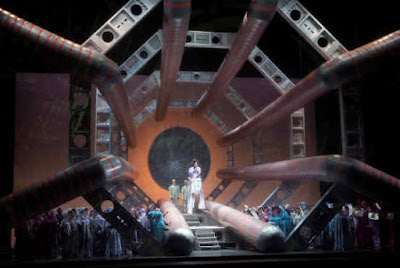Les Troyens from Valencia, with La Fura dels Baus.
by Paul Pelkonen.
The new DVD recording of Les Troyens, (conducted by Valery Gergiev and filmed at the gorgeous Calatrava-designed Palau des Artes Reina Sofia in Valencia, Spain) is a performance that, like Berlioz' bipartite opera, splits squarely down the middle. Part of that is the return of Catalan theater troupe La Fura dels Baus, who apply some strange (but curiously literal) ideas to Berlioz's operatic version of the Aeneid.
Act I does have some impressive visuals. The slaying of the priest Laocoön and his sons is performed onstage, with two huge inflatable snakes tearing out their hearts. The Horse is a technological nightmare on wheels. The Greek Horse is a menacing electronic unit on massive wheels, which delivers a system-crashing computer virus, literally hacking down the fire-walls of Troy. Also impressive, the blood-drenched Psycho shower curtain accompanying the mass suicide at the end of Act II.
by Paul Pelkonen.
 |
| The hockey-loving Trojans upload the Horse. Picture by Tato Baeza. © 2010 Palau de les Arts Reina Sofía/Unitel |
Despite the onstage weirdness (which we'll get to in a minute) this is a compelling performance of the score, robustly conducted. Lance Ryan is a strong vocal presence as Énée, keeping his stamina up over five taxing acts. He looks remarkably like he did in Siegfried (staged at the same theater) recycling his bad-boy dreadlocks and keeping up the bluff charm.
Daniele Barcellona is a compelling, if motherly Didon, appearing from the depths of a particle accelerator like a sweet-singing God particle. Elisabete Matos is a compelling Cassandre, undercut by being forced to produce soprano chest tones while her character is confined to a wheelchair. Gabriele Viviani is good as the second tenor Chorèbe. Danish bass Stephen Milling is a welcome presence as Didon's minister Narbal.
Mr. Gergiev is at his best when the music he is conducting interests him. That is clearly the case here. Berlioz' burly choruses and spectacles (the Trojan March, the mass suicide at the end of Act II, the famous Royal Hunt and Storm) are played with power and enthusiasm, with the Orchestra de la Comunitat Valencia forces responding to his leadership. The arias tend to drag out, but that can be said for many performances of this score.
All this quality music-making is seriously undercut by the production, staged by Carlus Padrilla and his circus-like troupe. The ancient Trojans are portrayed as a society obsessed with contact sports and technology. All the warriors carry laptops, and are decked out in hockey jerseys, tae kwon do armor and lacrosse helmets. It looks like a hacker convention north of the Canadian border--or as if the props department raided a high school locker room. Even the ballet is staged as a modern boxing match, complete with round number cards and an actual ring on the stage.
 |
| Didon's court, a giant particle accelerator in Act III of Les Troyens. Picture by Tato Baeza © Palau de les Arts Reina Sofía/Unitel. |
The Carthaginian acts are equally modern, and equally bizarre. It was already mentioned that Didon holds court inside a particle accelerator (made from the same inflatables as the snakes in Act I.) Why is the Phoenician civilization living at CERN? Or did the Trojans go in the wrog direction after they left the shores of Anatolia? The Royal Hunt has a latex and fetish fashion show instead of a ballet, with cast members tricked out in more sporting goods. Iopas' famous "Sailor's Song" in Act V is a space-walk that would make Major Tom proud. Didon's final suicide is a literal ocean of blood, an idea recycled from Mr. Padrilla's staging of the Ring.
It is our polite suggestion that you listen to this performance. Let the music speak for itself, and stop worrying about the visuals.
Contact the author: E-mail Superconductor editor Paul Pelkonen.
It is our polite suggestion that you listen to this performance. Let the music speak for itself, and stop worrying about the visuals.
Contact the author: E-mail Superconductor editor Paul Pelkonen.


